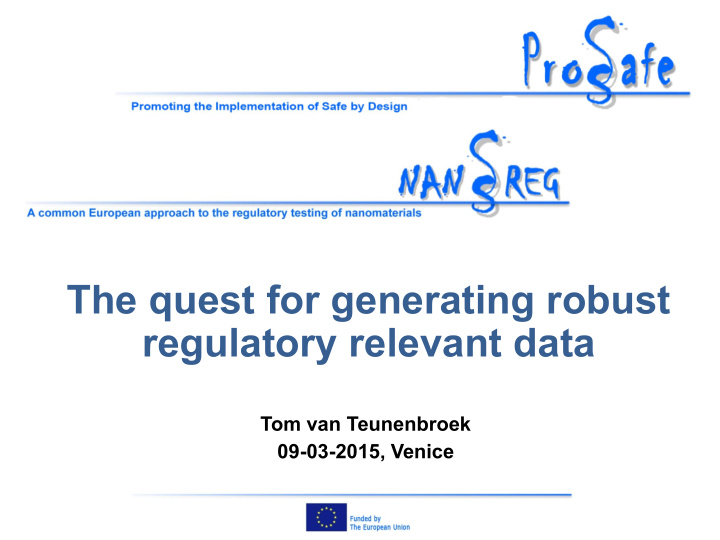



The quest for generating robust regulatory relevant data Tom van Teunenbroek 09-03-2015, Venice
Content of the presentation Introduction to NANoREG, context, main aims, first results and impact Introduction to ProSafe main aims, expected outcome ProSafe meets NANoREG (and others) quest for robust regulatory relevant data
Ten years of research >>100 milion euro investment and 10 years of research on EHS aspects of Nanomaterials Research on characterization, release, kinetics, mode of action etc. Dramatically increase of number of publications on EHS aspects. Still no-one can answer the question: are Nanomaterials a serious thread to environment and health?
Ten years of research Cause of this frustrating conclusion No central coordination: it’s all bottom up; “Let a 1000 flowers bloom”. Maybe appropriate for science and innovation; but for addressing societal worries and regulatory questions its rather inefficient V Data = R 2 EC
V RD = R 2 EC V RD : Value of generated regulatory data R eliability of generated EHS data is unknown R elevance of data is questionable E xchangeability of data is limited (no standardized ontology, no standardized way of reporting meta data, no system for data exchange C omparability insufficient because of difference in - methods, - materials, - operating practise
NANoREG: top-down Experience so far indicates there is a strong need for: Focus on regulatory needs and not (only) scientific needs: Methods and data that can be used in a regulatory context. Top down approach to assure R 2 EC. Basic condition for linking in vitro-in vivo, categorization, read across, etc. This, in a nutshell, is the basic philosophy of NANoREG.
NANoREG Project Factsheet Collaboration between 66 partners from: - 14 EU Member States - 2 Associated States (CH, NO), Involvement of industry (individual companies, CEFIC, NIA…) Collaboration Agreements with: Brazil and South Korea, Links to ECHA, OECD, ISO Links to ongoing EU FP7 projects Ca. 50 M € , (20% EC) 42 months duration; Started March 2013
NANoREG A common European approach to the regulatory testing of nanomaterials [www.nanoreg.eu]
Specific NANoREG Objectives Provide regulators with a set of tools for risk assessment and decision making instruments for the short to medium term, by gathering data and performing pilot risk assessment, including exposure monitoring and control, for a selected number of nanomaterials used in products, Develop for the long term, new characterization and testing strategies adapted to a high number of nanomaterials where many factors can affect their environmental and health impact, and Establish a close collaboration among authorities and industry with regard to the knowledge required for appropriate risk management , and create the basis for common approaches, mutually acceptable datasets and risk management practices.
What has been achieved so far? - 1 The Regulatory Questions have been refined (after a round of consultation) to focus on: measurement, characterisation, identification, transformation, dose metrics, metrological aspects, persistence and long term effects, kinetics, grouping, hazard, risk, exposure, etc. Public version of Deliverable available
What has been achieved so far? - 2 A Guidance Document on Minimum Requirements (for measurement and characterisation during testing) Aimed at obtaining reliable, comparable and exchangable data
What has been achieved so far? - 3 19 manufactured nanomaterials ( supplied by industry ) and additional alternative materials have been selected for mandated (!) use by NANoREG partners
What has been achieved sofar? - 4 SOPs for the creation of MNM dispersions for measurement and toxicity testing have been set and prescribed
What has been achieved sofar? - 5 Minimum characterisation requirements for the toxicological studies have been set and prescribed, and [excerpt from NANoREG Guidance Document]
What has been achieved sofar? - 6 … and what else are we doing: Most of planned R&D activities are pending; e.g. Characterisation of NMs; SOPs for primary particle size, VSSA, evaluation OECD TGs, (Critical) exposure scenarios, dustiness testing, exposure measurements, mesocosms, minimum characterisation requirements Long term inhalation study, prenatal study, in vivo genotoxicity and immune study (Preparatory work for) in vitro testing, comet assay, … and much more
Introduction to ProSafe Coordination and support action H2020 Startdate: 1 February 2015 Duration: 2 years 11 Partners plus Strategic Policy Development Group Main aim: coordination and strengthening existing and new initiatives on the field of nanosafety in a regulatory context FP7 & H2020, OECD, ECHA, EU-US.
Main aims of the ProSafe project White Paper: broadly accepted document; basis for regulator and industry to cover EHS aspects of Nms including SbD Evaluation of the OECD WPMN sponsorship programme and NANoREG I. Acceptance of the NANoREG safe innovation and safe-by-design concept Long term research goals (2015 - 2020 and 2020 - 2025) inclusive funding arrangements for EU-US research collaboration
Relations ProSafe
ProSafe supporting NANoREG
ProSafe influencing Safe by Design
ProSafe brings together NANoREG results: - Regulatory framework - Toolbox Safe by design (NANoREG and NANoREG II) Results evaluation OECD data Results other projects
Recommend
More recommend